Through a host of different tactics and strategies, the independent platform Artists Without a Cause (AWAC) aims to connect artists working in the political and social field with organizations and activists who are championing a cause. Organizers Diana Arce and Nine Yamamoto-Masson—both artists, researchers and activists themselves—provide the ground work for pairing artists in a contextual way with political organizations that could benefit from, and offer knowledge bases essential to, their work. We spoke to Arce and Yamamoto-Masson about the work they do with AWAC and what artistic activism has been inspiring them lately.
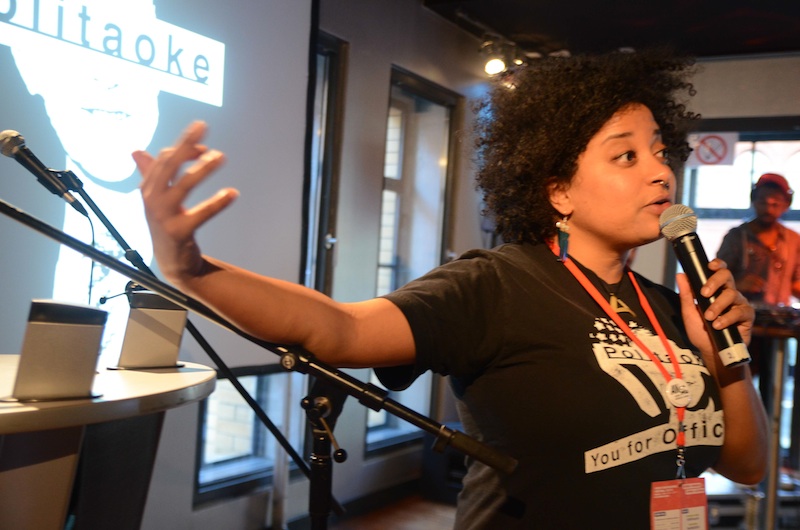
Politaoke at OKFest 2014 // Photo by Rahel Dette, courtesy of Diana Arce
BAL: How did you come to start AWAC and why do you feel it’s important to pair artists with activists in this way?
AWAC: [Diana Arce] Artists Without a Cause came out of a natural progression from my work as an artist. All of my work was focused on social, cultural and political topics and after creating my nonpartisan political speech karaoke bar project, ‘Politaoke’, in 2007, I was searching for ways to better utilize my work outside of the art context. With ‘Politaoke’, I experienced the effectiveness of making this kind of work and it’s ability to change minds. With each show on my Presidential Election Tour across the U.S. in 2008, I came into contact with participants who became motivated to become involved politically. Eventually, halfway through my tour, I worked with the now defunct, ‘Declare Yourself’, to offer voter registration materials at my shows. This was a very successful, albeit small, collaboration that made me interested in finding more definitive ways of working with other groups. I did not know this at the time, yet now clearly see and understand AWAC to be an extension of my work as an artist.
In 2013, I was invited to participate in Tactical Technology Collective’s ‘Info Activism Camp’ with over 120 activists from all over the world. We workshopped campaign strategies and methods and the first idea for AWAC came out of the work we did there. Many of the activists were interested in working with artists but had little to no experience with it and we eventually held a roundtable to bounce potential ideas. A few months later, a short concept paper of AWAC was created and I began working as AWAC. By 2014, we acquired nonprofit status, immediately after our first big collaboration with Open Knowledge Festival. We organized a festival within a festival and invited international artists to lead workshops on how to tell stories with open data. This first success set the stage for what we could do and how we wanted to work as AWAC.
By pairing artists and activists, each group is able to support the work of the other, through research, resource and labor-sharing. The artist has a platform to reach new audiences and the activist organizations have the artist-created platform as a way to build up their base and recruit new membership and interest in their work. This was very true of my work with ‘Politaoke’ and ‘Declare Yourself’. I was able to garner audience interest in the political processes and afterwards lead people to ‘Declare Yourself’ and their work.
To put it plainly, we believe that art can help change the world. If that is something an artist is interested in doing, who better to pair with then the activists and groups who are working to do that. What better way to support various causes then by using art as an entry point for gaining new interest and connecting people to the groups working on those causes. From the organizational perspective, collaborating with artists can help them tap into previously unavailable groups of people and garner more interest for their aims.
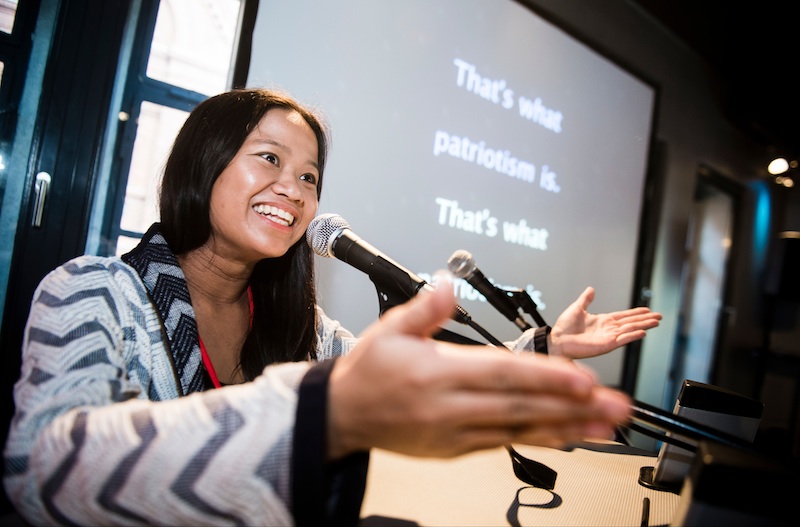
Politaoke at Open Knowledge Foundation-Festival 2014, from 15th to 17th of July at Kulturbrauerei in Berlin // Courtesy of Diana Arce, Copyright Gregor Fischer, 16.07.2014
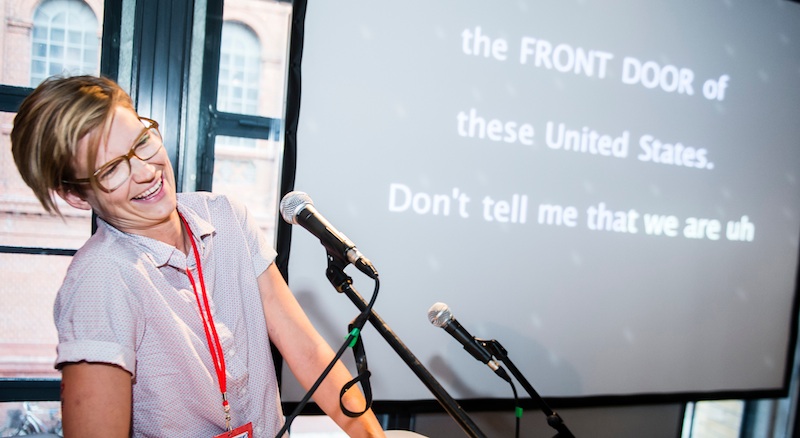
Open Knowledge Foundation-Festival 2014. From 15th to 17th of July at Kulturbrauerei in Berlin.
Copyright: Gregor Fischer, 16.07.2014
BAL: The ‘Knowledge Bank’ you offer acts as a database of research into artistic production in the activist context. What is your aim for helping to educate both artists and activists working together on future projects?
AWAC: The ‘Knowledge Bank’ is where we gather artworks we find impactful, and analyse why they are impactful (in our opinion), placing particular attention on dynamics of power and capital, sustainability, long-term impact, awareness of privileges and community-led empowerment. We research projects that reach audiences and encourage them to engage in social and political differences, collaborative works with marginalized communities that are mutually beneficial and art that utilizes public or alternative spaces outside of gallery and museum contexts. With this research, and referencing similar analysis by artists, thinkers, activists and organisations who we studied and/or are connected with, we will eventually put together an expanded guide of best practice both for artists and organizations that are interested in working with artists.
With this, we want to achieve two things: we want to encourage artists to make great, politically responsible and socially engaging artwork while reflecting on the structures and dynamics of power and art, and we want to show activist organizations the potential benefits of partnering and collaborating with artists.
Activists have in-depth knowledge about a given social issue and have identified goals, concrete steps and processes for how to move closer to those goals. Activist work is very demanding and comes with all kinds of pressures, challenges, urgent priorities: often activists might not have the time or headspace to think or produce a creative campaign or impactful, socially-engaged art project. Artists, on the other hand, have a lot of creative resourcefulness, and might want to put it in the service of a social cause or political struggle they support, but might not know how and not have that much in-depth knowledge about an issue. This partnering up and collaboration complements one another, and is in the service of a social cause or community.
BAL: The Matchmaking service helps to facilitate pairing artists and activist organizations from your network. What were your most successful Matchmaking endeavours?
AWAC: Our first major project with Open Knowledge Festival was definitely our most successful matchmaking so far. We lucked out with our first major project because the organizers of OKFest were extremely open to trying something completely different. This is not something that happens overnight. For the last several years, we spent quite a bit of time focusing on holding workshops for NGOs and their partners, going to conferences, networking with activists and organizations and working to develop the beginnings of our Knowledge Bank. As a part of AWAC, we continued to produce Politaoke and have been developing a toolkit and training program to teach other groups how to replicate the work. With this acquired knowledge and experience we plan on expanding our in real life offerings and will conduct the first Politaoke training with a help from a grant from Center for Artistic Activism, a creative activism nonprofit we admire and have worked with before.
Since Nine joined this year, we’ve been building relationships with organizations through more traditional formats in order to work up to more in-depth collaborations. We worked with Transgender Europe and Room 4 Resistance to put on two Art+Feminism wikipedia Edit-A-Thons, will host a series of film screenings in Berlin and are presenting our work at conferences and keynotes throughout Europe. We also hope to reboot a planned collaboration with Hackergram in India that was scrapped due to lack of funding and begin a new collaboration with a multicultural women’s center here in Berlin. We are definitely learning by doing and excited about the new work to come. We’ve also developed a database for artists to add themselves as potential collaborators on our website. Our dream would be to imbed artists within organizations similar to a residency, but more collaboratively, like a fellowship. We are working towards this goal by building trust with smaller scale projects and events.
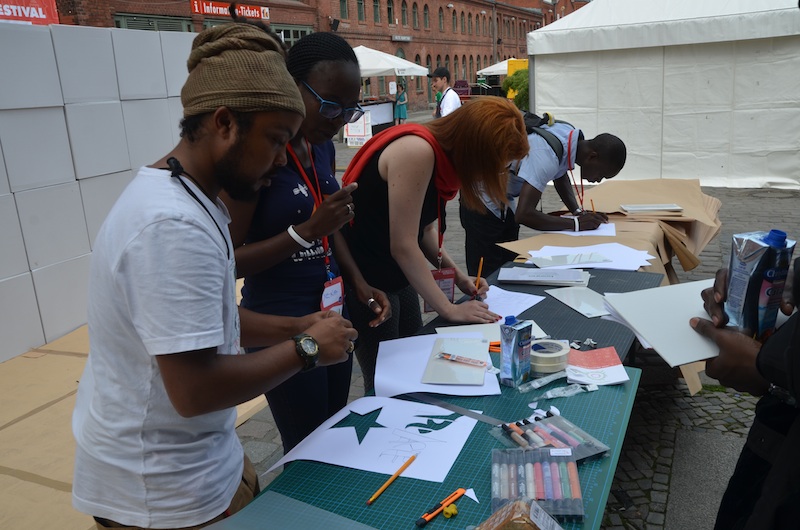
Graffiti Workshop from the Spray Uzi Crew from Kenya // Photo by Rahel Dette, courtesy of Diana Arce
BAL: How do you imagine that both activists and artists can maintain a certain autonomy, either from formal politics or the art world, while engaging with one another on creative projects? Do you see an inherent relationship between art or image-making and political interventions?
AWAC: First of all, these are not mutually exclusive categories. In fact, many activists are also artists and many artists also identify as activists. And, yes, we do believe that there is an inherent relationship between art and political intervention (whether this be visual art or other genres and media, e.g. poetry, music, performance). It’s the basis on which AWAC can exist.
As you say, it’s about a degree of autonomy. It is not possible to be entirely detached from these forces. The definition of “formal” politics is also up for debate: in the kinds of social and political issues we are active within and stand in solidarity with, it’s always about the people. For people who are of marginalized identities and who are negatively affected by systemic, structural oppression, even micro-details of everyday life are political, since their bodies and/or private lives are politicised by dominant culture, and thus their access to equal opportunities are constantly at stake. Being happy is political. Being alive is political.
It is crucial for activists and art professionals (whether artists, curators, institutions, educators, journalists) to be aware of their responsibilities, privileges, and the market forces they are entangled with (by this we also mean the attention economy, social and cultural capital) and to remember that our work is in service of the cause and of the people. What we mean by that is that it’s not only about activists and artists and their mutual engagement: it should be about the underlying struggle around which they come together, and which foregrounds the people and their futures, even if not all of them will go to the street to protest or are interested in art.
Accountability is as important as (a certain degree of) autonomy. There have been far too many art projects and activist projects by so-called allies that claim to “give voice to the voiceless” or “bring art to marginalised communities” – as if these people didn’t have voices, hadn’t been organising, speaking and raising awareness for their realities for a long time; as if these communities didn’t have any art or artists. The question of who will be preferentially heard, listened to, exhibited, interviewed, however, is one of privilege, and in the case of the art world often of white suprematist classism (i.e. access to a certain kind of art-speak).
So, in short, we would say that while engaging with one another on creative projects, artists and activists should always hold themselves and each other accountable to the cause and the people they serve.
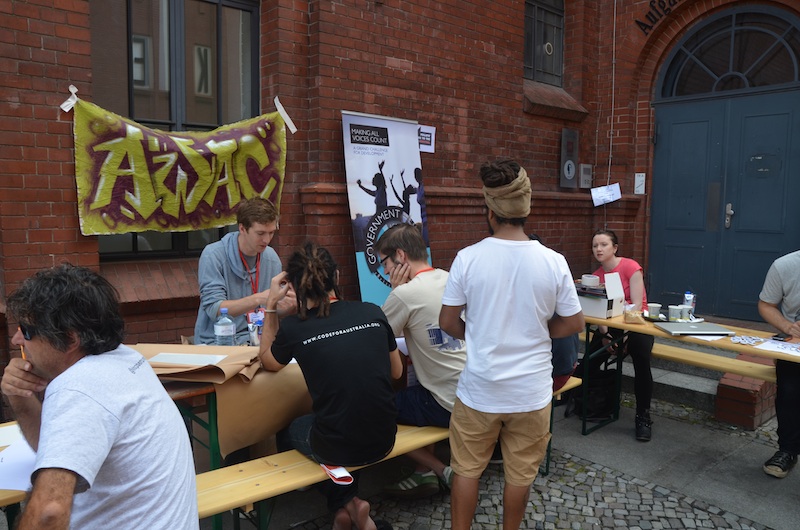
Graffiti Workshop from the Spray Uzi Crew from Kenya // Photo by Rahel Dette, courtesy of Diana Arce
BAL: What are some of your favourite examples of this kind of engagement?
“Favorite” is a difficult way of putting it. This is mostly a running list of artists and groups we’ve been looking at recently (many of whom we’ve met in person), who are shaping what we are thinking about now. You can also check out some of the people we’ve worked with before on our blog!
Simone Leigh‘s work at Free People’s Medical Clinic (FPMC) and Black Women Artists 4 BlackLivesMatter.
Forensic Architecture, a research agency based at Goldsmiths, University of London. It includes a team of architects, scholars, filmmakers, designers, lawyers and scientists to undertake research that gathers and presents spatial analysis in legal and political forums.
Ichimura Misako‘s work at Blue Tent Village, a homeless village in Yoyogi Park, Tokyo. Ichimura Misako is an artist, activist and community member.
Las Barcas journal of arts and theory from Okinawa.
Trap House Chicago, a restorative justice project (facilitated by artist, activist and educator Mashaun Ali Hendricks) that works with those closest to the issue, from the “bottom” up. It involves a broad spectrum of activities, from advocacy, consultancy and training of educators, to using streetwear and art as tools to transform culture, to move away from a toxic logic of punitive and retributive justice towards restorative justice.
Films and community arts projects produced and facilitated by Philip Jau Ding, a social activist from Malaysia who chairs the Baram Action Protection Committee and his fellow activists, who work with other activist organizations (such as the national coalition of Indigenous People, Jaringan Orang Asal SeMalaysia) and local artists to protest the building of dams in their lands, and fight corporate-driven ecological disaster and destruction of their communities.
‘Work is Work’, a zine by Hong Kong’s migrant workers, created in a series of zine-making workshops entitled Educate, Express, Empower: Breaking the Silence of Migrant Women, facilitated by artists Bea of Small Tune Press and two friends from Consider the Trouble and organised by the Hong-Kong based activist non-profit group Mission for Migrant Workers (MFMW).
Chicago Torture Justice Memorials (CTJM), which aims to honor and to seek justice for the survivors of Chicago police torture, their family members and the African American communities affected by the torture.
The VOICE Refugee Forum‘s projects that bring together activists of the Refugee-Migrant Community Network, anti-deportation activists and artists.



















